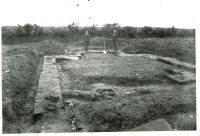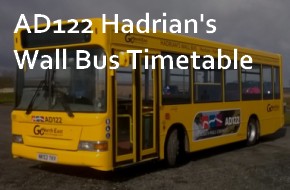Roman Maryport - Roman Temples Project
A team of archaeologists and volunteers led by Newcastle University’s Professor Ian Haynes with site director Tony Wilmott, are excavating on part of the Roman site at Maryport during June and July this year. The Roman Temples project is the start of a new phase in a five-year programme funded by the Senhouse Museum Trust, with in-kind support from Newcastle University, designed to better understand the environment in which the altars in the Senhouse Roman Museum were displayed.
The 23 Roman altars dedicated to Jupiter and other Roman gods by the commanders of the Maryport fort - one excavated in 2012 - form an important part of the collection at the Senhouse Roman Museum. The information they provide is of international importance for the study of the Roman army and its religious practices. The commanders identified come from as far afield as Africa and, in some cases we are able to establish their career histories, tracing their movements across the Roman Empire as they moved from posting to posting. This is the largest group of Roman military altars and inscriptions from any single find in Britain.
2011 Excavations
The results of the first year’s work in 2011 were extraordinary and unexpected. Until the excavation it was assumed by historians worldwide that the 17 Maryport altars found by Humphrey Senhouse in 1870 had been buried as part of a religious ceremony. The 2011 work established that this was not the case. The altars, from the second-century and still in good condition, were re-used in the foundations of a large Roman timber building or buildings near the highest point on the ridge overlooking the Solway and Maryport’s Roman fort. Only part of the ground-plan of the structure, or structures, was uncovered.
2012 Excavations
In 2012 the excavation covered a larger area of about 400 square metres. The partial plans of a building, or buildings on the site were recovered showing at least two phases of construction and the first complete altar was unearthed since 1870. The altar has the fifth inscription recovered from the Roman Empire to record T Attius Tutor, commander of the Maryport garrison, and a man known to have served at other times in Austria, Hungary and Romania.
A late Roman/early Medieval cemetery was also discovered. Finds from the graves were few, but included a bead bracelet and necklace and a tiny fragment of ancient textile, a remarkable survival.
Some of the burials may be contemporary with the famous early Christian sites at Whithorn and at Hoddom in nearby Dumfriesshire, which were active between the fifth and seventh centuries AD. The Maryport textile sample, from one of the earliest graves in the cemetery was sent for radiocarbon dating. The results show that the wool from which the textile was woven was most probably sheared sometime between AD 240 and AD 340. The glass necklace, bracelet and loose beads are being conserved and will be displayed in the Senhouse Roman Museum.
2013 Excavations
 This year sees some further work at the 1870 site and the start of a three year project focusing on the place where, in 1880, local bank manager and amateur archaeologist Joseph Robinson (photo left courtesy of the Senhouse Museum Trust) uncovered further altars and two possible temples.
This year sees some further work at the 1870 site and the start of a three year project focusing on the place where, in 1880, local bank manager and amateur archaeologist Joseph Robinson (photo left courtesy of the Senhouse Museum Trust) uncovered further altars and two possible temples.
Photographs and other documents from the 1880s indicate that the antiquarian investigation only unearthed part of the site and it is clear that much remains to be discovered.
For further information on the project go to the Senhouse Museum website.
Roman Temples Project Blog
Read the blog from the Roman Temples Project by Professor Ian Haynes and Tony Wilmott.
How to See the Excavations
The excavation will be open to visitors as part of a visit to the museum between Monday 10 June and Monday 22 July every day except Saturday and Sunday starting at 2pm and 3.30pm. All public access will be by guided walks to the site led by the museum's volunteer guides followed by a tour of the excavation led by one of the site supervisors. The Senhouse Roman Museum will be open every day 10am to 5pm. Adult £3, child £1, family £8.
School Visits
Schools and other organised groups should contact the museum in advance to arrange a visit on 01900 816168 or email [email protected]
Other Roman excavations are happening throughout Hadrian's Wall Country.


.gif)


 button to add an item to your Itinerary basket.
button to add an item to your Itinerary basket.
